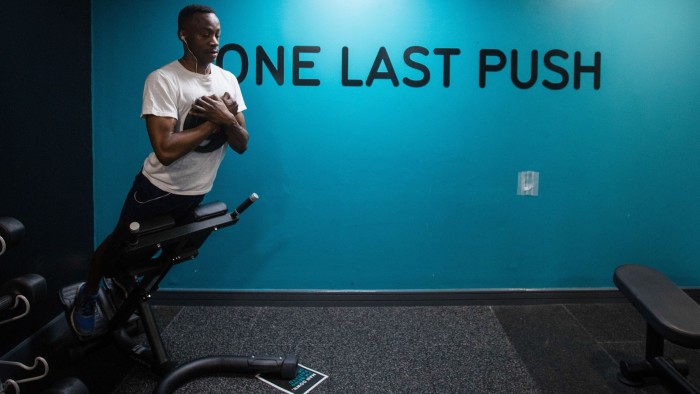Budget gym chains are eyeing expansion in smaller UK towns, cities and retail parks following several years of blockbuster growth, with openings by value operators far outpacing those of their more expensive rivals.
The number of gyms run by the dominant trio of PureGym, The Gym Group and JD Gyms in places with a population of 10,000 to 75,000 people more than doubled between 2019 and 2024 to hit 168 sites, according to an analysis by Savills.
The low-cost gym sector as a whole increased by about 30 per cent to 372 new locations in the period, while the total number of new gyms, including mid-market and higher-end operators, increased by 15 per cent to 447.
In separate research Savills noted that PureGym was, excluding restaurants, the brand which had the most openings in retail parks in 2023 with JD Gyms among the top 15.
PureGym chair Humphrey Cobbold said the company was focused on opening in residential areas and towns with populations of about 20,000 to 25,000 following its early growth in big cities.
Cobbold said that the lack of rivals in these smaller areas meant PureGym could sometimes charge a higher rate. “Everybody is happy because [customers] have got a gym they never had before, and it’s still great value,” he added.
PureGym, which was founded in 2008, is now the largest gym operator in the UK with nearly 400 sites and plans to open at least 200 more in the next three to four years, with some sites as small as 5,000 sq ft — or only a quarter of the size of a typical UK gym.
Examples of openings in smaller towns in 2024 include Spalding in Lincolnshire and Llantrisant in Wales, and it also has centres in areas such as Witney in Oxfordshire and Barnstaple in Devon. Cobbold predicted that the market share of the budget segment out of the total would “definitely grow to being 40 per cent,” up from today’s 20 per cent.
Meanwhile, rival The Gym Group is expanding in urban residential areas, including sites within retail parks.
“High-value, low-cost gyms are just becoming more and more part of everyday life . . . I wouldn’t expect [the rollout of the sector] to slow anytime soon,” chief executive Will Orr said.
The group typically charges about £24 a month. It has more than 240 outlets and plans to open 50 more by the end of 2026. “There is a lot of white space still available to these players,” Orr added.
Despite an interruption during Covid-19 lockdowns UK budget gyms have exploded in popularity over the past decade as consumers grow increasingly health conscious. The sector is valued at £888mn and accounts for a fifth of the total private gym market overall, up from just 6 per cent in 2013, according to Leisure DB.
However, Greg Johnson at Shore Capital warned that, although he expected them to continue to gain market share, overexpansion was a risk. “Probably the biggest risk in the medium term is that they open too many new gyms and the market becomes saturated quicker than envisaged,” he said.
The number of low-cost clubs grew 9 per cent between 2019 and 2024 to 743 while the number of other types of gyms fell 1 per cent to 3,770, Leisure DB said.
Based on Leisure DB’s research, PwC says it expects the UK could have up to 850 more low-cost gyms.
By not providing swimming pools, saunas and spas, which are expensive to run, and keeping staff to a minimum, the sites can keep their costs low and charge customers less — but prices are on the rise, driven in part by more branches being in smaller locations.
“We’ve seen low-cost gyms doing quite well in smaller towns because there’s no competition,” said Douglas Jack, analyst at Peel Hunt. “[Even though] you’re opening a smaller place, which is a little inefficient, you can charge more because people [used to] travel into big towns or cities to stay healthy and fit.”
The average monthly fee for a low-cost gym has risen above £24, albeit still less than half of the £52 typically charged by operators, including mid- to upper-range, according to Leisure DB. However, more than 89 per cent of all UK low-cost clubs now charge £20 or more a month, a surge from 54 per cent in 2022, partly due to inflation but also pushed by strong demand.
“In 2023, we saw the largest number of low-cost clubs disappearing into the mid-market,” said David Minton, founder of the industry intelligence company, which defines low-cost clubs as those charging members less than £25.
While companies cited energy and staff costs as the reasons for raising their prices, “what [operators] realised was that they were providing a service that people were prepared to pay more for. So they had actually looked at the price elasticity of each site and discovered that they were artificially holding the price low,” Minton said.
Leisure DB found that PureGym has on average increased its monthly price by 4 per cent between 2023 and 2024 to £25.40 while The Gym Group raised it by 9 per cent to £23.82.
Nevertheless, their overall affordability is helping them acquire Gen-Z customers for whom “going to the gym is a more social activity than it’s ever been”, according to Orr. A company survey in October showed 53 per cent of respondents aged 18-24 said they spent more on health and fitness than they did a year ago, prioritising it over other forms of consumer spending.
Read the full article here

